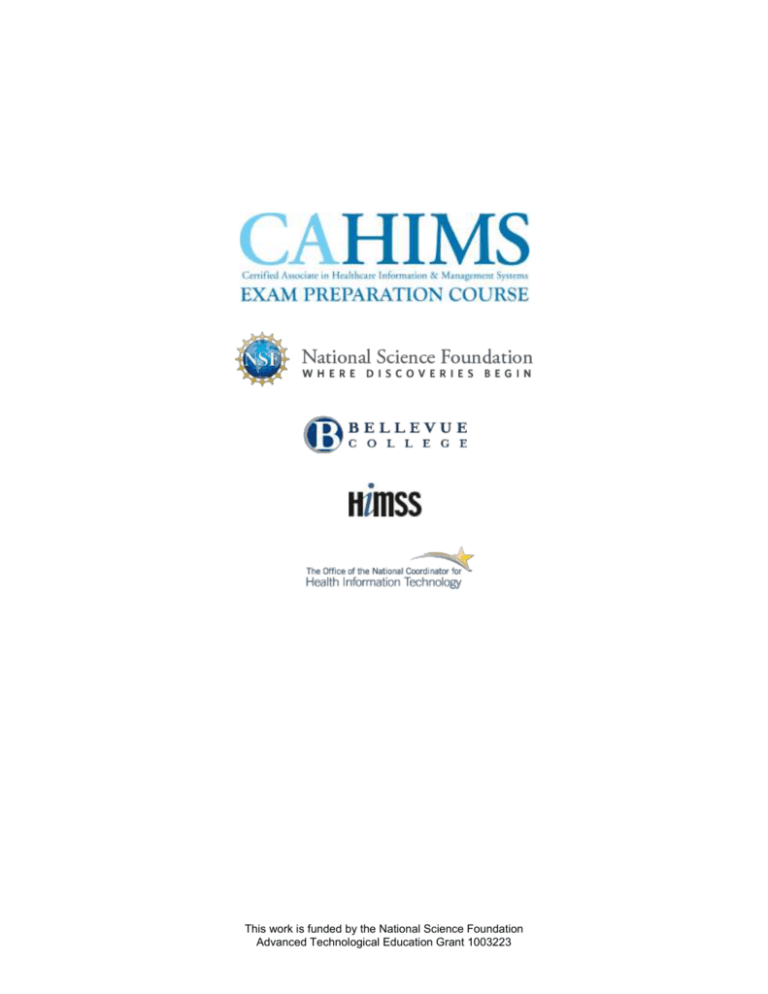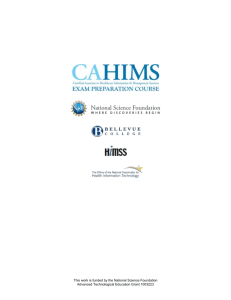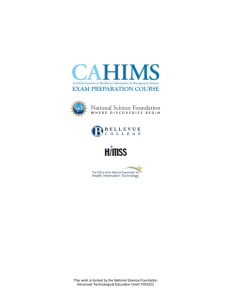8.1-Assessment-Key
advertisement

This work is funded by the National Science Foundation Advanced Technological Education Grant 1003223 The CAHIMS Exam Preparation Course and the CAHIMS exam are the result of collaboration between the Life Science Informatics Center at Bellevue College and the Healthcare Information and Management Systems Society (HIMSS). Significant content found in the CAHIMS Exam Preparation Course stems from the Office of the National Coordinator for Health Information Technology. Creation of the CAHIMS Exam Preparation Course and the CAHIMS exam was made possible through support from the National Science Foundation (NSF). Curriculum Team: Margaret Schulte, DBA Michèle Royer, PhD Nathan Savage, MLIS This work is funded by the National Science Foundation Advanced Technological Education Grant 1003223 Section 8 - Leadership and Planning Lesson 8.1 - Leadership and Change Management Assessment Questions Answer Key Lecture 6 1. According to the lecture, which best describes change management? a. The systematic process of updating existing technology or implementing new technology to maintain a competitive edge b. The methodology that integrates change and the ability to adapt to change in an organization. *c. A strategic systematic process for engaging stakeholders during the metamorphosis of establishing new ideas or practices d. The reconstructive process of managerial roles to conform to new standards, procedures and applications Answer: c. A strategic systematic process for engaging stakeholders during the metamorphosis of establishing new ideas or practices Lecture(s)/Slide(s): 6/5 2. According to the lecture, all are characteristic of change management EXCEPT: a. Anticipation of conflicts and snags b. Framework design that supports integration of diverse perspectives for goal achievement c. Elasticity in maneuvers and outcome model *d. Ridged approach and task focused Answer: d. Ridged approach and task focused Lecture(s)/Slide(s): 6/10 3. The effects of information system change on individuals and organizations include all EXCEPT: a. Ambiguity in job descriptions b. Increased interdependence with duties of others c. Opportunities for facilitating innovative initiatives *d. Reliance on successful standard procedures Answer: d. Reliance on successful standard procedures Lecture(s)/Slide(s): 6/12 This work is funded by the National Science Foundation Advanced Technological Education Grant 1003223 Page 1 4. Which of the following represents the most critical question for implementation teams to ask during the planning stages of change management strategies? a. What will change? b. What will remain the same? *c. Why is there a need for change? d. How will change occur? Answer: c. Why is there a need for change? Lecture(s)/Slide(s): 6/14 5. According to the lecture, which of the following is a catalyst for change when supported by data and a strategic vision? a. Charismatic leadership b. Incentives c. Technology *d. Tension Answer: d. Tension Lecture(s)/Slide(s): 6/16 6. In which phase of organizational the “CHANGE” model should the communication plan be developed? a. A – Articulate Goals b. C – Create Tension *c. H – Harness Support d. N – Nominate Roles Answer: c. H – Harness Support Lecture(s)/Slide(s): 6/17 7. Charlotte has twenty-five years of work experience for Historic Hospital. She perceives appropriate resources for responsibilities. In which phase of organizational “CHANGE” would she be the greatest asset? a. A – Articulate Goals b. G - Grow capability c. H – Harness Support *d. N – Nominate Roles This work is funded by the National Science Foundation Advanced Technological Education Grant 1003223 Page 2 Answer: d. N – Nominate Roles Lecture(s)/Slide(s): 6/19 8. Carl communicates statistical and technical information in a manner in which both technically adept and technically challenged people find pleasurable. In which two phases of organizational “CHANGE” would Carl’s skill set be most needed? a. C and H – Create Tension and Harness Support b. A and N – Articulate Goals and Nominate Roles *c. G and E – Grow Capability and Entrench Changes d. E and C – Entrench Changes and Create Tension Answer: c. G and E – Grow Capability and Entrench Changes Lecture(s)/Slide(s): 6/21 9. Which of the following is the primary sign of successful health information change management? *a. The change results in better outcomes within an expeditious timeline b. Entrenched changes are accepted with adequate additional support c. Patient care becomes the primary focus of technology support d. Healthcare employees efficiently use technology and readily adapt to future challenges Answer: a. The change results in better outcomes within an expeditious timeline Lecture(s)/Slide(s): 6/22 10. Which of the following best describes what is required to create “organization nimbleness”? a. Excellent communication b. Understanding human behavior *c. Skillful change management d. Understanding an organization’s structure Answer: c. Skillful change management Lecture(s)/Slide(s): 6/24 This work is funded by the National Science Foundation Advanced Technological Education Grant 1003223 Page 3 Lectures 1 & 2 11. Managers do all of the following EXCEPT *a. set direction. b. bring consistency. c. reduce chaos. d. cope with complexity. Answer: a. set direction. Lecture(s)/Slide(s): 1/5 12. Leaders and followers have a higher degree of collaboration during which part of a project? a. Pre-project Planning b. Beginning of Project *c. Middle of Project d. End of Project Answer: c. Middle of Project Lecture(s)/Slide(s): 1/16 13. Grayson and Speckhart believe which of the following about leaders and followers? *a. Getting to know the “Number Two” leader is important b. Followers prefer to be lead c. Leaders cannot also be followers d. Followers cannot grow in to good leaders Answer: a. Getting to know the “Number Two” leader is important Lecture(s)/Slide(s): 1/12 14. Alignment of leaders and followers is important because a. followers must have a directive before they can act. b. followers do not always understand strategic objectives or direction. *c. most projects have a lot at stake and alignment is crucial to decision making. d. leaders need to know that the followers will be loyal to them. Answer: c. Most projects have a lot at stake and alignment is crucial to decision making. This work is funded by the National Science Foundation Advanced Technological Education Grant 1003223 Page 4 Lecture(s)/Slide(s): 1/12 15. Leaders do all of the following EXCEPT a. cope with change. b. align resources. c. set direction. *d. cope with complexity. Answer: d. cope with complexity. Lecture(s)/Slide(s): 1/5 16. Projects can be managed differently according to the environment of an organization. Which one of the following is NOT an environment described by the Project Management Institute (PMI)? a. Functional b. Matrix *c. Hybrid d. Projectized Answer: c. Hybrid Lecture(s)/Slide(s): 2/5 17. In a functional organizational environment, who is typically in charge? a. Project Manager b. Project Sponsor c. Project Team *d. Department Manager Answer: d. Department Manager Lecture(s)/Slide(s): 2/6 18. In a matrixed organization, authority for projects is shared between a. the Project Sponsor and Project Manager. *b. the Functional Manager and Project Manager. c. the Functional Manager and Vendor. d. the Project Manager and Vendor. Answer: b. the Functional Manager and Project Manager. This work is funded by the National Science Foundation Advanced Technological Education Grant 1003223 Page 5 Lecture(s)/Slide(s): 2/9 19. Which reason describes why today’s leaders cannot “expect” followership? a. Many decisions formerly made by leaders can now easily be made with the assistance of computers, software and other technology b. Regulations require equal rights for all workers *c. More people than ever now have access to information to formulate their own knowledgeable judgments d. Information interchange has decreased the need and dependence on a leader Answer: c. More people than ever now have access to information to formulate their own knowledgeable judgments Lecture(s)/Slide(s): 1/10 20. Which option is not a requirement for a HIT implementation manager? a. Understand complex environments *b. Use the same project management style to ensure consistent outcomes c. Maintain working relationships from previous projects d. Research functional manager’s responsibilities Answer: b. Use the same project management style to ensure consistent outcomes Lecture(s)/Slide(s): 2/17 21. Which option provides items like the schedule of vendor resources, a list of project resources, and their roles and responsibilities? *a. Communications Plan b. Implementation Management Plan c. Project Update Plan d. Organization Calendar Answer: a. Communication Plan Lecture(s)/Slide(s): 2/19 This work is funded by the National Science Foundation Advanced Technological Education Grant 1003223 Page 6 22. Which set describes the three key factors for an Implementation Manager’s success? a. Stimulate positive attitudes, communicate circumspectly, and clarify authority roles b. Make deadlines, deliver services, depart with good relationships c. Handle stress well, utilize downtime to communicate updates, follow guidelines *d. Praise accomplishments, take time to understand people, and focus on the finish line Answer: d. Praise accomplishments, take time to understand people, and focus on the finish line Lecture(s)/Slide(s): 2/22, 23, 24 Lectures 3, 4 & 5 23. In the context of leadership, authority can be defined as *a. the right to use power legitimately. b. the ability to convince people to do something they ordinarily would not do. c. using power to make something happen. d. the right to control the actions of others. Answer: a. the right to use power legitimately. Lecture(s)/Slide(s): 3/6, 7 24. Authority belongs to a role that is a. defined and communicated. *b. sanctioned and mutually recognized. c. recognized and communicated. d. mutually recognized. Answer: b. sanctioned and mutually recognized. Lecture(s)/Slide(s): 3/8 25. All of the following statements are true about charismatic leaders EXCEPT a. charismatic leaders galvanize their followers through their personalities. b. charismatic leaders may not always have an official title. c. charismatic leaders often emerge in crisis situations. *d. charismatic leaders demand respect from their followers. This work is funded by the National Science Foundation Advanced Technological Education Grant 1003223 Page 7 Answer: d. charismatic leaders demand respect from their followers. Lecture(s)/Slide(s): 3/11 26. Ethnic, racial and religious groups are referred to as a. minorities. *b. subcultures. c. counter-cultures. d. cultural groups. Answer: b. subcultures. Lecture(s): 3/21 27. In order for an organization to foster creativity, it must *a. encourage creativity at all levels of the organization. b. institute a creativity-training program. c. devote portions of each worker’s time to “creative time.” d. document and measure all creative ideas on a scale. Answer: a. encourage creativity at all levels of the organization Lecture(s)/Slide(s): 3/16 28. Self-awareness, one of the four competencies of social intelligence, includes all of the following traits EXCEPT a. having an honest view of one’s self. *b. being prone to outbursts of anger or frustration. c. having high impulse control. d. having an understanding of one’s strengths and weaknesses. Answer: b. being prone to outbursts of anger or frustration. Lecture(s)/Slide(s): 4/6 29. Being able to sense and perceive emotions other than one’s own means that one a. has good social skills. *b. is socially aware. c. is self-aware. d. is self managed. This work is funded by the National Science Foundation Advanced Technological Education Grant 1003223 Page 8 Answer: b. is socially aware. Lecture(s)/Slide(s): 4/9 30. Emotional intelligence refers to a. the ability of someone to perform well in scholarly work. *b. the ability for someone to process his/her emotions and the emotions of others. c. the ability for someone to be agreeable and optimistic. d. the ability of someone to perform well in social situations. Answer: b. the ability for someone to process his/her emotions and the emotions of others. Lecture(s)/Slide(s): 4/3 31. A leader with good sense of self-management will have all but which of the following characteristics? a. Adaptability b. Ability to express emotions if they’re warranted c. Trustworthiness *d. Impulsivity Answer: d. Impulsivity Lecture(s)/Slide(s): 4/8 32. Which of the following is NOT characteristic of a leader with good social skills? a. Is influential and communicative *b. Is polite and cordial c. Is adept at managing conflict d. Can develop others and build bonds Answer: b. Is polite and cordial Lecture(s)/Slide(s): 4/9 This work is funded by the National Science Foundation Advanced Technological Education Grant 1003223 Page 9 33. Which is NOT vital for creativity in a healthcare environment? a. Persistent leaders *b. Inward focus on patient safety c. Assessment of the marketplace d. Tolerant leaders Answer: b. Inward focus on patient safety Lecture(s)/Slide(s): 3/19 34. Group leaders should motivate members using which of the following elements of group dynamics? a. Strategic thinking b. Common goals *c. Individual goals d. Long-range plans Answer: c. Individual goals Lecture(s)/Slide(s): 5/17 35. Examples of intrinsic motivation include all but which of the following? a. Completing a degree b. Quitting smoking *c. Entering a sales contest d. Completing a marathon Answer: c. Entering a sales contest Lecture(s)/Slide(s): 5/5 36. Which of the following is an example of a team? a. Committee b. Council *c. Management d. Task forces Answer: c. Management Lecture(s)/Slide(s): 5/7 This work is funded by the National Science Foundation Advanced Technological Education Grant 1003223 Page 10 37. Intrinsic motivation is doing something because a. people will like you. b. you will be promoted. *c. it's the right thing to do. d. you will receive financial gain. Answer: c. it’s the right thing to do. Lecture(s)/Slide(s): 5/11 This work is funded by the National Science Foundation Advanced Technological Education Grant 1003223 Page 11





